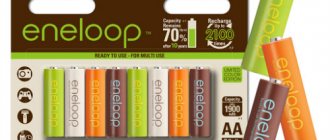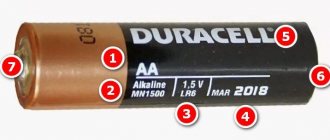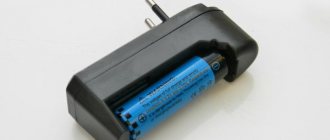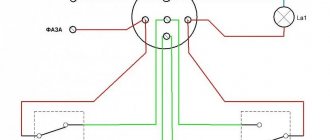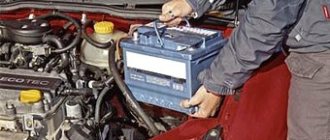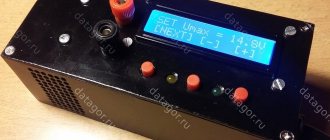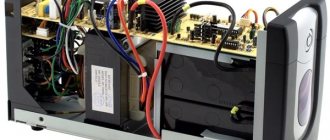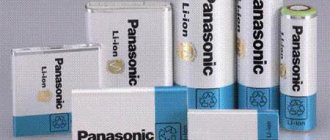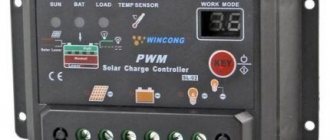For normal operation of any battery, you must always remember "The Three P's Rule"
:
- Don't overheat!
- Do not recharge!
- Do not overdischarge!
You can use the following formula to calculate the charging time for a NiMH or multi-cell battery:
Charging time (h) = Battery capacity (mAh) / Charger current (mA)
Example: We have a battery with a capacity of 2000mAh. The charging current in our charger is 500mA. We divide the battery capacity by the charging current and get 2000/500=4. This means that at a current of 500 milliamps, our battery with a capacity of 2000 milliamp hours will charge to full capacity in 4 hours!
And now in more detail about the rules that you need to try to follow for the normal operation of a nickel-metal hydride (Ni-MH) battery:
- Store Ni-MH batteries with a small amount of charge (30 - 50% of its rated capacity).
- Nickel-metal hydride batteries are more sensitive to heat than nickel-cadmium (Ni-Cd) batteries, so do not overcharge them. Overloading can negatively affect the battery's current output (the battery's ability to hold and release its accumulated charge). If you have a smart charger with “ Delta Peak
” technology (interrupting the battery charge when the voltage reaches a peak), then you can charge batteries with virtually no risk of overcharging and destroying them. - Ni-MH (nickel metal hydride) batteries can (but not necessarily!) be “trained” after purchase. 4-6 charge/discharge cycles for batteries in a high-quality charger allows you to reach the limit of capacity that was lost during the transportation and storage of batteries in questionable conditions after leaving the manufacturing plant. The number of such cycles can be completely different for batteries from different manufacturers. High-quality batteries reach their capacity limit after only 1-2 cycles, while batteries of questionable quality with artificially high capacity cannot reach their capacity limit even after 50-100 charge/discharge cycles.
- After discharging or charging, try to let the battery cool to room temperature (~20 o C). Charging batteries at temperatures below 5 o C or above 50 o C can significantly affect battery life.
- If you want to discharge a Ni-MH battery, do not discharge it to less than 0.9V for each cell. When the voltage of nickel batteries drops below 0.9V per cell, most chargers with "minimal intelligence" cannot activate the charge mode. If your charger cannot recognize a deeply discharged cell (discharged less than 0.9V), then you should resort to using a “dumb” charger or connect the battery for a short time to a power source with a current of 100-150mA until the battery voltage reaches 0.9V.
- If you constantly use the same battery assembly in an electronic device in recharging mode, then sometimes it is worth discharging each battery from the assembly to a voltage of 0.9V and fully charging it in an external charger. This complete cycling procedure should be performed once every 5-10 battery recharging cycles.
Charging table for typical Ni-MH batteries
| Element capacity | Standard size | Standard charging mode | Peak charge current | Maximum discharge current |
| 2000 mAh | A.A. | 200mA ~ 10 hours | 2000 mA | 10.0A |
| 2100 mAh | A.A. | 200mA ~ 10-11 hours | 2000 mA | 15.0A |
| 2500 mAh | A.A. | 250mA ~ 10-11 hours | 2500 mA | 20.0A |
| 2750 mAh | A.A. | 250mA ~ 10-12 hours | 2000 mA | 10.0A |
| 800 mAh | AAA | 100mA ~ 8-9 hours | 800 mA | 5.0 A |
| 1000 mAh | AAA | 100mA ~ 10-12 hours | 1000 mA | 5.0 A |
| 160 mAh | 1/3 AAA | 16mA ~ 14-16 hours | 160 mA | 480 mA |
| 400 mAh | 2/3 AAA | 50mA ~ 7-8 hours | 400 mA | 1200 mA |
| 250 mAh | 1/3 AA | 25mA ~ 14-16 hours | 250 mA | 750 mA |
| 700 mAh | 2/3 AA | 100mA ~ 7-8 hours | 500 mA | 1.0A |
| 850 mAh | FLAT | 100mA ~ 10-11 hours | 500 mA | 3.0A |
| 1100 mAh | 2/3 A | 100mA ~ 12-13 hours | 500 mA | 3.0A |
| 1200 mAh | 2/3 A | 100mA ~ 13-14 hours | 500 mA | 3.0A |
| 1300 mAh | 2/3 A | 100mA ~ 13-14 hours | 500 mA | 3.0A |
| 1500 mAh | 2/3 A | 100mA ~ 16-17 hours | 1.0A | 30.0 A |
| 2150 mAh | 4/5 A | 150mA ~ 14-16 hours | 1.5A | 10.0 A |
| 2700 mAh | A | 100mA ~ 26-27 hours | 1.5A | 10.0 A |
| 4200 mAh | Sub C | 420mA ~ 11-13 hours | 3.0A | 35.0 A |
| 4500 mAh | Sub C | 450mA ~ 11-13 hours | 3.0A | 35.0 A |
| 4000 mAh | 4/3 A | 500mA ~ 9-10 hours | 2.0A | 10.0 A |
| 5000 mAh | C | 500mA ~ 11-12 hours | 3.0A | 20.0 A |
| 10000 mAh | D | 600mA ~ 14-16 hours | 3.0A | 20.0 A |
The data in the table is valid for completely discharged batteries
It is impossible to properly charge battery power sources without understanding how charge times are calculated.
And this can be done in two ways:
1. Using our online calculator. 2. Make your own calculation using the formula.
How to store nickel batteries
Nickel batteries must be fully charged the night before the game. It is not recommended to store them when fully charged. But you also can’t leave them completely discharged for a long time - this way you will “kill” the batteries with a 100% chance. After which they will have to be restored. This procedure is complex, long and not always successful.
For long-term storage, charge batteries to approximately 40-50% of their capacity. The charging time can be calculated using the same formula. Since the accumulation of capacity when charging with constant microcurrent occurs almost linearly, simply divide the total charging time in half.
For very long-term storage (6 months or more), it is recommended to periodically discharge the batteries and then charge them with microcurrent. But you should not repeat this procedure too often, since with each cycle the battery gradually wears out.
How long does it take to charge batteries?
The charging time can be determined by dividing the battery capacity by the charger current. In this case, it is important to take into account the coefficients of conversion of electricity into heat, energy dissipation coefficients, which take values from 1.2 to 1.6.
The charge coefficient can be taken from the calculation of the ratio of the charge current to the battery capacity. The greater this difference, the larger the coefficient should be used.
Note: the online calculator “how long to charge batteries”, located above this article on our website, works in a similar way.
Technical specifications
- resistance R5 within hundreds of ohms;
- stabilization voltage 4.9V;
- voltage stability when the load changes from 20 mA to 1 A;
- upper current limit 0.5 A;
- heating of the transistor no more than 50-60oC;
- charging current 200 mA.
Varieties by charging type
There are two types:
- Automatic. Such devices choose the current and duration themselves; you just need to specify the battery parameters.
- Reversible pulse. Everything is configured manually, which can sometimes speed up the process and sometimes slow it down greatly.
For beginners and those who do not practice professionally, automatic options are recommended.
How to use devices, instructions
Standard algorithm:
- Measure the battery charge with a multimeter.
- If it is below 20%, you can start charging.
- Place the battery in the charging position.
- Select mode, duration, current, resistance.
- Wait until charging finishes.
- Test by measuring with a multimeter.
Some batteries can be charged without harm even if the charge is above 20%.
Features of the formula
The above formula:
charging time = (battery capacity / charging current) * coefficient
is advisable if the following conditions are met:
1. The battery charge time is within 4-20 hours, no more and no less.
If the charging time is less than 4 hours: a full-fledged charger that supplies similar currents must automatically stop supplying electric current. The battery can then be removed and used.
If the charging time is more than 20 hours: there is no point in worrying about harm to the batteries. Such low charging currents will not harm the batteries.
Moreover, the battery can remain in low-power chargers for almost a whole week! (6-7 full days without visible damage to the battery).
2. Battery capacity - indicated on the packaging, on the case, in the attached documentation, in the instructions, on the battery case. Units of measurement are mAh (milliamp-hours, ampere-hours).
3. Charging current - indicated on the case, in the instructions, in the documentation, set manually, reflected on the display (if any) of the charger. Units of measurement are mA (milliamps, amperes).
How often should you discharge?
Unlike lead-acid cells, NiCads are charged using a constant current source. Their internal resistance is such that if constant voltage were used, they would draw excessively high currents which could damage the cells.
Typically cells charge at a rate of about C/10. In other words, if their capacity is 1 amp hour, they will charge at a rate of 100 mA. Charging times typically exceed ten hours because not all the energy entering the cell is converted into stored electrical energy.
It is found that during the first stage of charging, up to approximately 70% full charge, the charging process is almost 100% efficient. After that he falls.
Time definition examples
Given: Battery capacity - 1000 mAh Charger current - 150 mAh Coefficient - 1.2-1.6 (1.4 average) Charging time - (1000/150) * 1.4 = 9.3 hours (9 hours 15 -20 minutes).
This will be the AVERAGE charging time, because... we took the average coefficient - 1.4 (the same value is in the online calculator)!
In this case, the battery charging speed may vary depending on:
- temperature;
- chemical composition of batteries;
- initial charge stored in the battery.
Charge/discharge characteristics
The NiMH cell has many characteristics similar to NiCd, such as the discharge curve (subject to additional charging) that the battery can accept. It is intolerant of overcharging, which causes capacity degradation, which poses a serious problem for charger designers.
The current characteristics that are necessary in order to properly charge a NiMH battery are:
- Rated voltage - 1.2V.
- Specific energy - 60-120 W-hour/kg.
- Energy density - 140-300 W-hour/kg.
- Specific power - 250-1000 W/kg.
- Charge/discharge efficiency - 90%.
The charging efficiency of nickel batteries ranges from 100% to 70% of full capacity. Initially there is a slight increase in temperature, but later as the charge level rises, the efficiency drops, generating heat, which must be taken into account before charging NiMH.
When a NiCD battery is discharged to a certain minimum voltage and then charged, steps must be taken to reduce the conditioning effect (approximately every 10 charge/discharge cycles) otherwise it will begin to lose capacity. NiMH does not require such a requirement because the effect is negligible.
However, this recovery process is also convenient for nickel-metal hydride devices and is recommended to be taken into account before charging NiMH batteries. The process is repeated three to five times before they reach full capacity. The conditioning process of rechargeable batteries ensures that they will last for many years.
Number of cycles
It is worth remembering that each time you recharge a battery, its service life deteriorates. Thus, for nickel-cadmium batteries no more than 1000-1500 discharge/charge cycles are allowed.
For modern batteries, they are trying to increase this figure, bringing it to 4000 cycles.
And if a brand new rechargeable battery has completed the full “training” course 3-4 times, then it is considered that it has reached performance characteristics that will be maintained throughout its entire service life.
You can learn about how to properly use rechargeable batteries, precautions and other tricks:
- in technical documentation;
- in the operating instructions;
- in the articles on our site.
The lifespan of an average rechargeable battery is 3 years.
AA batteries are the most common and sold along with pinky batteries. They are a type of finger-type battery and have been produced since 1907. Galvanic batteries have characteristics that are optimally suited for many modern devices. This leads to a wide scope of application, a large selection among domestic and foreign manufacturers.
Contents
Power supplies marked AA have different characteristics depending on the type of electrode installed. But they also have identical characteristics. First of all, these are the sizes.
Battery AA li-ion
AA AA batteries are a cylinder with a diameter of 13.5 to 14.5 millimeters. The length together with the contact protrusion (it occupies about a quarter of the main diameter) is 50.5 millimeters. The cylindrical part is completely covered with an insulated shell to avoid possible short circuits or corrosion.
The terminals are located on different sides of the battery. On the positive terminal there is a protrusion, the height of which is about 1 millimeter. A negative terminal is a flat or slightly raised surface.
The weight of power supplies varies. Salt ones weigh approximately 14-18 grams, alkaline ones - from 22 to 24 grams, and nickel ones - 30 grams. The latter option is equipped with a voltage converter, therefore such batteries can be charged, that is, they perform the functions of batteries and in fact are them.
Design and principle of operation
A battery is an electrochemical device in which electrical energy is converted and stored in chemical form. Chemical energy is easily converted into electrical energy. NiMH works on a principle based on the absorption, release and transfer of hydrogen within two electrodes.
NiMH batteries consist of two metal strips that act as positive and negative electrodes, and an insulating foil separator between them. This energy “sandwich” is wound and placed in the battery along with liquid electrolyte. The positive electrode is usually made of nickel, the negative electrode is made of metal hydride. Hence the name NiMH, or nickel metal hydride.
Advantages:
- Contains fewer toxins and is environmentally friendly and recyclable.
- The memory effect is higher than Ni-Cad.
- Much safer than lithium batteries.
Flaws:
- Deep discharge shortens life and generates heat during fast charging and high load.
- Self-discharge is higher compared to other batteries and must be taken into account before charging NiMH.
- A high level of maintenance is required. The battery must be completely discharged to prevent crystal formation during charging.
- More expensive than Ni-Cad battery.
Lithium-ion battery (li-ion)
An important characteristic of the charger is the charge current:
- with low current - gentle mode, there will be no overheating, but charging may take up to a day;
- with average current - do not heat up, practically do not affect the service life, charging lasts about 6 hours;
- with high current - very fast charging in a few hours, but if the battery is of poor quality, it can quickly become unusable.
Attention is also paid to the possibility of memorization. Chargers with intelligence function select the appropriate mode and time.
There is no need to perform any special manipulations. Most chargers are powered by AC power, so the voltage needs to be more or less stable. Batteries can be charged at any stage, but it is advisable to complete the charging cycle (this protects the filling from rapid deterioration). The main thing is not to confuse the polarity.
There is no particular difference between AA batteries from different manufacturers. The main thing is to pay attention to the type of power source and the difference in capacity. Devices from Eneloop, Robiton, Varta, GP, Duracell, Xiaomi, Camelion have a good quality-to-price ratio.
Battery AA NiСd
First of all, you need to pay attention to the type and decoding of the values. Depending on the device for which AA AA batteries are selected. You should also pay attention to:
- current strength;
- voltage (from 1.25 to 3.7 Volts);
- capacity;
- power;
- life time;
- charge-discharge cycle;
- operating temperature range.
A properly selected device can last up to 20 years. Of course, this period depends on the intensity of use.
We often miss good shots in the forest or at sea, we may be late or stumble in the dark because a simple battery from a camera, watch or flashlight suddenly runs out. It's hard to say exactly when the charge will be used up, unless this is a Duracell model with an indicator. But don't despair! Thanks to a few tips, you can avoid unpredictable situations and take the intended photographs from a digital camera, find out the exact time, illuminate the road, etc. In this article, we will tell you how to charge batteries at home without a charger, which will make life much easier in unpredictable situations.
Know that to charge alkaline batteries you can use a special charger that can relatively quickly restore a discharged item. But each charging session will reduce its operating life by approximately 1/3. In addition, leakage is possible.
Note! At home you can charge: alkaline (alkaline) AA batteries. Don't: salt. The possibility of leakage or even explosion cannot be ruled out!
Charging can be done using various methods. Therefore, you should not throw away an element as soon as it stops serving. A few recommendations - and he is back in action. The first method, using which you can charge AA batteries yourself without a charger. We connect the power supply to the network. Next, using the connection wires, we connect the used battery to the unit. Don't forget about polarity: plus is connected to plus, and minus is connected to minus. It’s quite easy to find where the “-\+” of a discharged object is: they are marked on the body.
Having connected the battery to the power source, wait until it warms up to fifty degrees and turn off the power. Next, wait a few minutes for the heated object to cool down. Otherwise, it may explode. Then, while the AA is still warm, it needs to be charged in a different way. It consists of the following: connect the power supply to electricity and disconnect it. This should take about 120 seconds. Next, we place the object to be charged in the “freezer” for 10 minutes, then take it out and wait 2-3 minutes for it to warm up. That's it, the charge is restored right at home without a charger! You can safely use it for the same computer mouse.
Main rules:
- The charge is not feasible if you arrange the + and - in a different way. On the contrary, the battery will drain even faster.
- It is permissible to charge the object at home 1-2 times.
- Using the method described above, you can only charge simple AA alkaline batteries.
- The charge can be carried out in any ambient temperature conditions.
Another charging method is the conventional heating method. But it is fraught with consequences (explosion). In this way, you can restore, again, small alkaline batteries at home. You can also charge them in a simpler way - place discharged objects in hot water, but for no more than 20 seconds, otherwise sad results are possible. Another simple way is to flatten or reduce the volume of the element with your own hands. This way you can charge various AA batteries. There is an example when a person, after the charge of a cast-ion battery had expired, simply took it out and stomped on it, after which the charge indicator showed one hundred percent.
You can also restore the charge without a charger this way: we make 2 holes with an awl near each carbon rod with a depth of three-quarters of the height of the element itself. We pour liquid into them and seal them, covering them with resin or plasticine. You can pour not just liquid, but an eight to ten percent solution of hydrochloric acid or double vinegar. Pour the solution several times to ensure sufficient saturation. This method allows you to charge up to seventy to eighty percent of the initial capacity.
Video instructions for restoring Duracell using phone charging
Another way to charge the product: open the cell cover with a knife. If the zinc cylinder, the object's rod and the carbon powder are intact, then immerse the object in the salt solution. Its ratio is as follows: 2 tablespoons of table salt per several glasses of liquid. Next, boil the solution together with the element for about ten to fifteen minutes. Then we return the gaskets responsible for sealing to their place and cover them with wax or plasticine.
In the modern world there are many devices and rechargeable batteries are already a necessity. While some people change one battery after another, others simply charge the battery. In order for the product to last as long as possible, it is necessary to follow the recommendations for charging and operation and select them in accordance with the requirements of the devices.
Contents
Features and application of Ni-cd batteries
Compared to metal hydride batteries, Ni-Cd batteries have two main disadvantages:
- smaller capacity;
- memory effect.
The memory effect is the “remembering” of the lower discharge limit by the battery. That is, if such a battery is not completely discharged, the duration of operation in the next cycle will be less by the same amount from the full discharge to the limit that the battery “remembered”. To “reset” the memory, you need to fully charge and discharge such a battery two or three times.
It would seem that with such properties, this type of battery should go into oblivion. But this doesn't happen. Thanks to two other properties of this type of battery:
- high current output;
- ability to work well at low temperatures.
Approximately 90% of Ni Cd today is battery assemblies for power tools, children's toys, electric shavers, autonomous vacuum cleaners, medical equipment, etc. Application in the household segment (instead of conventional primary batteries) is practically reduced to zero.
Some countries legally restrict the use of Ni-Cd elements due to the toxicity of cadmium. In new devices, their place is taken by lithium-ion batteries with high current output.
What batteries can be charged?
You can only charge rechargeable batteries that are marked as such on the case. It is forbidden to insert the most ordinary models into the memory, no matter what type they are - AA or smaller.
Battery AA NiСd
If you violate safety rules, be prepared for:
- Nothing will happen, then you can be considered lucky;
- The battery will hiss and deteriorate;
- Overheating, fire and even explosion are possible;
- Short circuit in the network.
Depending on the materials, batteries are of the following types:
- Nickel metal hydride;
- Nickel-cadmium;
- Nickel-zinc NiZn;
- Lithium-ion;
- Lithium polymer.
The nickel-cadmium battery has a memory effect, so it must be fully discharged and recharged. Nickel metal hydride also has a memory effect, but it is kept to a minimum.
Rechargeable batteries have standard sizes similar to classic models:
- Little finger (AAA)
- Finger (AA).
- Thumbelina type C.
- Keg or D battery.
- Crown or Corundum.
- 1/2 AA.
- Large square.
There can be both batteries and accumulators of such standard sizes, because of this it is very important not to confuse them. It's worth noting that there are no coin cell batteries, with the exception of a limited edition for hearing aids.
There are also Li-Ion batteries in the following sizes, and they can be charged:
| Designation | Height, mm | Diameter, mm | Voltage, V |
| 10180 | 18 | 10 | 3,7 |
| 10280 | 28 | 10 | 3,7 |
| 10440 (AAA) | 44 | 10 | 3,7 |
| 14250 | 25 | 14 | 3,7 |
| 14500 (AA) | 50 | 14 | 3,7 |
| 15270 | 27 | 15 | 3,7 |
| 16340 | 34.5 | 17 | 3,7 |
| 17500 | 50 | 17 | 3,7 |
| 17670 | 67 | 17 | 3,7 |
| 18500 | 50 | 18 | 3,7 |
| 18650 | 65 | 18 | 3,7 |
| 22650 type B | 65 | 22 | 3,7 |
| 25500 type C | 50 | 25 | 3,7 |
| 26650 | 65 | 26 | 3,7 |
| 32600 type D | 61 | 34 | 3,7 |
The type of battery is selected for specific devices. Cameras will accept AA, but some toys will require a barrel. The most popular are still 10440 and AAA.
Battery capacity can vary from 150 mAh to 6000 mAh. The larger the capacity, the more expensive the device. The capacity size is indicated on the case in large letters. The larger the capacity, the longer the device can work.
“Training” the batteries
Due to the aforementioned “memory effect”, nickel-metal hydride batteries must be subjected to so-called “training” immediately after purchase. That is, the first 5-6 times they need to be completely discharged and charged. Only after this do they acquire the nominal indicated capacity. Therefore, it is recommended to spend some time to “prepare” new batteries for play.
But this only applies to high-quality, expensive batteries. Inexpensive “noname” models often require several dozen charging cycles to reach full capacity.
Why can't you charge regular batteries?
Disposable cells have a completely different operating principle - ions flow from the electrolyte to the electrodes. Over time, their supply runs out, and then the battery runs out. If you pass current through a conventional model, the recovery process simply will not occur. For example, during operation of zinc-manganese batteries, the zinc electrode will dissolve.
The batteries are designed in such a way that the indicators of electrolytes and electrodes can be returned to the original version. When such a battery is connected to a charger, oxygen and hydrogen ions are converted from the electrolyte. The reduction process begins, where hydrogen acts as a catalyst for converting the cathode into lead, and oxygen – the anode into lead dioxide.
Adapter Specifications
An important issue is battery life, or the overall cost over the life of the system. In this case, manufacturers offer devices with microprocessor control.
Algorithm for an ideal charger:
- Soft start. If the temperature is above 40 degrees or below zero, start with charging C/10.
- Option. If the voltage of the discharged battery is higher than 1.0 V/cell, discharge the battery to 1.0 V/cell and then proceed to fast charging.
- Fast charging. At 1 degree until the temperature reaches 45 degrees or dT indicates full charge.
- After fast charging is completed, charge at C/10 for 4 hours to ensure a full charge.
- If the voltage of a charged NiMH battery rises to 1.78 V/cell, stop working.
- If the fast charging time exceeds 1.5 hours without interruption, it is stopped.
In theory, trickle charging is a charge rate that is high enough to keep the battery fully charged, but low enough to avoid overcharging. Determining the optimal charging rate for a particular battery is a little difficult to describe, but it is generally accepted that it is around ten percent of the battery's capacity, for example, for a Sanyo 2500mAh AA NiMH, the optimal charging rate is 250mA or lower. This must be taken into account in order to properly charge NiMH batteries.
How to determine if it is a battery or an accumulator
Before purchasing, you should know a few nuances that will help you identify regular batteries from rechargeable ones:
- Pay attention to the inscription on the case. If there is a capacity, then it is a battery; it is indicated in mah (milliamps) per hour. The higher this indicator, the longer it will last.
- If the case says rechargeable, then it is rechargeable. If the inscription sounds like do not recharge, then recharging is prohibited.
- Please pay attention to the cost of the product. Regular batteries are cheaper than rechargeable batteries. The price directly depends on power indicators and recharge cycles.
- Rechargeable batteries have a greater safety margin. They last a long time and charge gradually, but ordinary batteries stop functioning when connected to more powerful devices.
- The battery boasts a voltage of ~1.5 V, but the battery has a voltage of ~1.2v, ~3.7v. The crown will have 9 volts in both cases.
- If the markings on the case contain the letters: R, CR, LR and FR, then this is a battery.
- If the case is marked with: NiCd, Ni-MH, Ni-Zn, HR, ZR, KR, li-ion or li-pol, then this is a battery.
By following simple steps, everyone can determine the necessary batteries for themselves.
In the picture on the left there is a battery, as it is written on the case: 850 mAh, rechargeable and nickel metal hydride. On the right is the battery, as it only says Alkaline.
Rules for using nickel-metal hydride batteries
The service life of ni mh batteries largely depends on whether the power source is allowed to overheat or be significantly overcharged. Additionally, experts advise taking into account the following rules:
- Regardless of how long the power supplies will be stored, they must be charged. The charge percentage must be at least 50 of the total capacity. Only in this case there will be no problems during storage and maintenance.
- Batteries of this type are sensitive to overcharging and excessive heating. These indicators have a detrimental effect on the duration of use and the amount of current output. These power supplies require special chargers.
- Training cycles are not necessary for NiMH power supplies. With the help of a proven charger, lost capacity is restored. The number of restoration cycles largely depends on the condition of the unit.
- Be sure to take breaks between recovery cycles and also study how to charge a used battery. This time period is required for the unit to cool down and the temperature level to drop to the required level.
- The recharging procedure or training cycle is carried out only in an acceptable temperature range: +5-+50 degrees. If you exceed this figure, the likelihood of rapid failure increases.
- When recharging, make sure that the voltage does not drop below 0.9 volts. After all, some chargers do not charge if this value is minimal. In such cases, it is possible to connect an external source to restore power.
- Cyclic restoration is carried out provided that there is some experience. After all, not all chargers can be used to discharge a battery.
- The storage procedure includes a number of simple rules. It is not allowed to store the power source outdoors or in rooms where the temperature level drops to 0 degrees. This provokes solidification of the electrolytic composition.
If not one, but several power sources are charged at the same time, then the degree of charge is maintained at the set level. Therefore, inexperienced consumers carry out battery restoration separately.
Nimh batteries are effective power sources that are actively used to complete various devices and units. They stand out with certain advantages and features. Before using them, it is necessary to take into account the basic rules of use.
How to properly charge a battery
- Before charging at home, read the instructions for the device and recommendations from the manufacturer.
- Modern batteries do not have a memory effect, so there is no need to pump up the battery. With the exception of nickel-cadmium (Ni-Cd) batteries.
- Observe temperature conditions, do not insert into the charger at temperatures below 5 degrees and above 50 degrees Celsius.
- Select a charger specifically for batteries; it’s good if this was done right away. Keep in mind that the slower the energy charge is delivered, the better.
- Do not leave the battery in the charger for more than a day. If they are not charged, then there is no point in continuing.
Important! When charging, the battery will heat up, this is normal, but it should not be very hot; if it seems to you that it is overheating very much in the charger, then stop the procedure.
Types of charging nickel-metal hydride batteries
Now, let's take a closer look at the features of different types of charging.
Trickle charging of Ni─MH batteries
It is worth saying here that this type of charging does not increase the service life of Ni─MH batteries. Since trickle charging does not turn off even after a full charge, the current is selected very small. This is done to ensure that the batteries do not overheat during long-term charging. In the case of Ni─MH batteries, the current value can even be reduced to 0.05C. For nickel-cadmium, 0.1C is suitable.
With drip charging, there is no characteristic maximum voltage and the only limitation for this type of charging can be time. To estimate the required time, you will need to know the capacity and initial charge of the battery. To calculate charging time more accurately, you need to discharge the battery. This will eliminate the influence of the initial charge. The efficiency of trickle charging of Ni─MH batteries is 70 percent, which is lower than other types. Many manufacturers of nickel-metal hydride batteries do not recommend using trickle charging. Although recently more and more information has appeared that modern models of Ni─MH batteries do not degrade during trickle charging.
Fast charging of nickel-metal hydride batteries
Manufacturers of Ni─MH batteries in their recommendations provide characteristics for charging with a current value in the range of 0.75─1C.
Focus on these values when choosing what current to charge Ni─MH batteries. Charge currents higher than these values are not recommended as this may cause the safety valve to open to relieve pressure. It is recommended to quickly charge nickel-metal hydride batteries at a temperature of 0-40 degrees Celsius and a voltage of 0.8-8 volts. The efficiency of the fast charging process is much greater than that of drip charging. It is about 90 percent. However, by the time the process is completed, the efficiency decreases sharply, and the energy turns into heat release. The temperature and pressure inside the battery rise sharply. Ni-MH batteries have a safety valve that can open when the pressure increases. In this case, the properties of the battery will be irretrievably lost. And the high temperature itself has a detrimental effect on the structure of the battery electrodes. Therefore, we need clear criteria by which the charging process will be stopped.
We will present the requirements for the charger (charger) for Ni─MH batteries below. For now, we note that such chargers charge according to a certain algorithm. The stages of this algorithm are generally as follows:
- determining the presence of a battery;
- battery qualification;
- pre-charge;
- transition to fast charging;
- fast charging;
- recharging;
- maintenance charging.
Let's look at these stages in more detail.
Determining the presence of a battery
At this stage, a current of 0.1C is applied and the voltage at the poles is checked. To start the charging process, the voltage should be no more than 1.8 volts. Otherwise the process will not start.
It is worth noting that checking for the presence of a battery is carried out at other stages. This is necessary in case the battery is removed from the charger.
If the memory logic determines that the voltage value is greater than 1.8 volts, then this is perceived as the absence of a battery or its damage.
Battery qualification
Here you can determine an approximate estimate of the battery charge. If the voltage is less than 0.8 volts, then fast charging of the battery cannot be started. In this case, the charger will turn on pre-charging mode. During normal use, Ni─MH batteries rarely discharge to voltages below 1 volt. Therefore, pre-charging is activated only in the case of deep discharges and after long-term battery storage.
Pre-charge
As mentioned above, pre-charging is activated when Ni─MH batteries are deeply discharged. The current at this stage is set at 0.1─0.3C. This stage is limited in time and lasts somewhere around 30 minutes. If during this time the battery does not restore the voltage to 0.8 volts, then the charge is interrupted. In this case, the battery is most likely damaged.
Transition to fast charging
At this stage, there is a gradual increase in the charging current. The current increases smoothly over 2-5 minutes. At the same time, as at other stages, the temperature is controlled and the charge is turned off at critical values.
Fast charging
The charge current at this stage is in the range of 0.5─1C. The most important thing at the fast charging stage is to turn off the current in a timely manner. To do this, when charging Ni─MH batteries, control is used according to several different criteria.
For those who are not aware, when charging Ni─Cd batteries, a delta voltage control method is used. During the charging process it constantly grows, and at the end of the process it begins to fall. Typically, the end of the charge is determined by a voltage drop of 30 mV. But this control method does not work very well with nickel-metal hydride batteries. In this case, the voltage drop is not as pronounced as in the case of Ni─Cd. Therefore, to trigger the shutdown, you need to increase the sensitivity. And with increased sensitivity, the likelihood of false alarms due to battery noise increases. In addition, when charging several batteries, the operation occurs at different times and the whole process is blurred. But still, stopping charging due to a voltage drop is the main thing. When charging with a current of 1C, the voltage drop to turn off is 2.5-12 mV. Sometimes manufacturers set detection not by a drop, but by the absence of a change in voltage at the end of the charge.
In this case, during the first 5-10 minutes of charging, the voltage delta control is turned off. This is because when fast charging starts, the battery voltage can change greatly as a result of the fluctuation process. Therefore, at the initial stage, the control is turned off to eliminate false alarms.
Due to the not very high reliability of switching off charging based on the voltage delta, control is also used based on other criteria.
At the end of the Ni─MH battery charging process, its temperature begins to rise. This parameter is used to turn off the charge. To exclude the value of the OS temperature, monitoring is carried out not by absolute value, but by delta. Typically, a temperature increase of more than 1 degree per minute is taken as a criterion for stopping charging. But this method may not work at charge currents less than 0.5 C, when the temperature rises quite slowly. And in this case, the Ni-MH battery can be recharged. There is also a method for monitoring the charging process by analyzing the voltage derivative. In this case, it is not the voltage delta that is monitored, but the rate of its maximum increase. The method allows you to stop fast charging slightly before the charge is complete. But such control is associated with a number of difficulties, in particular, more accurate voltage measurement.
Some chargers for Ni─MH batteries use pulsed rather than direct current for charging. It is delivered for a duration of 1 second at intervals of 20-30 milliseconds. Experts cite a more uniform distribution of active substances throughout the battery volume and a reduction in the formation of large crystals as the advantages of such a charge. In addition, more accurate voltage measurements are reported between current injections. As a development of this method, Reflex Charging was proposed. In this case, when applying a pulsed current, the charge (1 second) and discharge (5 seconds) alternate. The discharge current is 1─2.5 times lower than the charge. The advantages include a lower temperature during charging and the elimination of large crystalline formations.
When charging nickel-metal hydride batteries, it is very important to monitor the end of the charging process using various parameters. Emergency termination methods must be provided. For this purpose, the absolute temperature value can be used. Often this value is 45-50 degrees Celsius. In this case, the charge must be interrupted and resumed after cooling. The ability of Ni─MH batteries to accept a charge at this temperature decreases.
It is important to set a charge time limit. It can be estimated by the battery capacity, the charging current and the efficiency of the process. The limit is set at the estimated time plus 5-10 percent. In this case, if none of the previous control methods work, the charge will turn off at the set time.
Recharge phase
At this stage, the charging current is set to 0.1─0.3C. Duration about 30 minutes. Longer recharging is not recommended as it will shorten battery life. The recharging phase helps equalize the charge of the cells in the battery. It is best if, after fast charging, the batteries cool down to room temperature, and then recharging starts. Then the battery will restore its full capacity.
Maintenance charging
Chargers for Ni─Cd batteries often switch the batteries into trickle charging mode after completing the charging process. For Ni─MH batteries, this will only be useful if a very small current is supplied (about 0.005C). This will be enough to compensate for battery self-discharge.
Ideally, the charger should have the function of enabling maintenance charging when the battery voltage drops. Maintenance charging only makes sense if a sufficiently long time elapses between charging the batteries and using them.
Ultra-fast charging of Ni-MH batteries
And it’s also worth mentioning the ultra-fast charging of batteries. It is known that when charged to 70 percent of its capacity, a nickel-metal hydride battery has a charging efficiency close to 100 percent. Therefore, at this stage it makes sense to increase the current to speed up its passage. In such cases, currents are limited to 10C. The main problem here is determining those 70 percent of the charge at which the current should be reduced to normal fast charging. This greatly depends on the degree of discharge at which the battery began charging. High current can easily lead to overheating of the battery and destruction of the structure of its electrodes. Therefore, the use of ultra-fast charging is recommended only if you have the appropriate skills and experience.
Smart devices iMax B6
In order to charge the NiMH iMax you will need a special charger as using the wrong method can render the battery useless. Many users consider the iMax B6 to be the best choice for NiMH charging. It supports the process of up to 15 cell batteries, as well as many settings and configurations for different battery types. The recommended charging time should not exceed 20 hours.
As a rule, the manufacturer guarantees 2000 charge/discharge cycles from a standard NiMH battery, although this number may vary depending on operating conditions.
Work algorithm:
- Charging NiMH iMax B6. You must connect the power cord to the outlet on the left side of the device, taking note of the shape at the end of the cord to ensure the correct connection is made. We insert it all the way and stop pressing when a sound signal and a welcome message appear on the display screen.
- Use the silver button on the far left to view the first menu and select the type of battery to charge. Pressing the leftmost button will confirm the selection. The button on the right will scroll through the options: charge, discharge, balance, fast charge, storage and others.
- Two central control buttons will help you select the desired number. By pressing the rightmost button to enter, you can move to the voltage setting by scrolling again using the two center buttons and pressing enter.
- Use several cables to connect the battery. The first set looks like lab wiring equipment. It often comes complete with alligator clips. Connection sockets are located on the right side of the device near the bottom. They are fairly easy to spot. This is how you can charge NiMH with the iMax B6.
- Then you need to connect the free battery cable to the end of the red and black clamps, creating a closed loop. This can be a bit risky, especially if the user makes the wrong settings the first time. Press and hold the enter button for three seconds. The screen should then inform you that it is checking the battery, after which the user will be asked to confirm the mode setting.
- While the battery is charging, you can scroll through the different display screens using the two central buttons, which provide information about the charging process in different modes.
Mode setting
To properly charge a Ni-Cd battery, you need to know the rules for setting up the equipment (if provided by the manufacturer). The nominal capacity of the battery must have a charge current of up to 2 C. It is necessary to select the type of pulse. It can be Normal, Re-Flex or Flex. The sensitivity threshold (pressure reduction) should be 7-10 mV. It is also called Delta Peak. It is better to set it at the minimum level. The pumping current needs to be set in the range of 50-100 mAh. To be able to fully utilize the battery power, you need to charge with a high current. If its maximum power is required, the battery is charged with low current in normal mode. By looking at how to charge Ni-Cd batteries, every user will be able to complete this process correctly.
Flaws
One of the disadvantages of the presented devices is the fact that the user must learn how to properly charge Ni-Cd batteries. The presented batteries, as mentioned above, are characterized by a “memory effect”. Therefore, the user must periodically carry out preventive measures to eliminate it.
The energy density of the presented batteries will be slightly lower than that of other types of autonomous power sources. In addition, in the manufacture of these devices, toxic materials that are unsafe for the environment and human health are used. Disposal of such substances requires additional costs. Therefore, in some countries the use of such batteries is limited.
After long-term storage, Ni-Cd batteries require a charge cycle. This is due to the high self-discharge rate. This is also a disadvantage of their design. However, knowing how to properly charge Ni-Cd batteries and operate them correctly, you can provide your equipment with an autonomous power source for many years.
